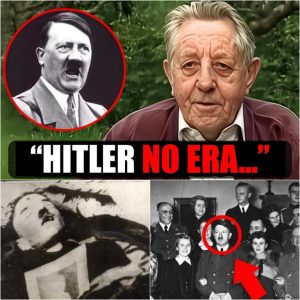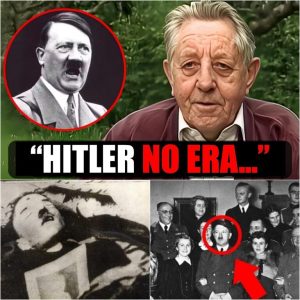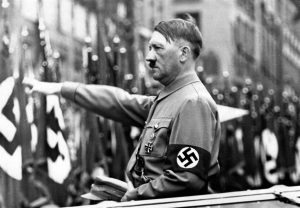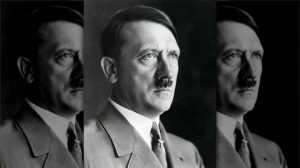Breaking News: “Before I Die, I Must Reveal the Truth”: Hitler’s Cousin Breaks 70-Year Silence, Unveiling a Disturbing Secret That Has Been Hidden for Decades!
Eighty years later, a secret SAS mission has come to light, revealing an audacious plan aimed at capturing or eliminating the Nazi general Erwin Rommel during World War II. This operation, involving meticulous details, has the potential to change the course of the conflict as we know it. Known as the Desert Fox, Rommel was an instrumental figure in Hitler’s war machine, commanding German forces in North Africa following the Normandy landings in June 1944, and later, in France. The mission, codenamed Operation Gaff, was designed to break the stalemate that the Allies faced in the weeks following D-Day, a time when the Allies were deeply concerned that Nazi resistance could extend the war in Europe. Authorized by Field Marshal Bernard Montgomery, this daring operation included a team of six elite soldiers from the British Special Air Service (SAS), whose task was as perilous as it was fascinating: to eliminate or extract one of Nazi Germany’s most brilliant strategists.

The plan was surprisingly detailed. After the SAS, under Major Bill Fraser, identified a French chateau in La Roche-Guyon, located 80 kilometers west of Paris, where Rommel was staying, they devised a direct action strategy. A sharpshooter was to hide in the woods across the Seine from the château and shoot Rommel from a distance of 365 meters while he casually strolled through the estate’s Italian gardens. Should they successfully apprehend him alive, an airplane was to land on a prepared runway nearby, allowing for his covert extraction from Nazi-occupied France. Intelligence reports on Rommel were extensive, outlining his movements to and from the chateau. Military historian Damien Lewis, author of SAS Daggers Drawn, describes the operation as one of the boldest missions of the Second World War, aiming to strike at the heart of the Nazi command and send a clear signal of strength to the Allies.
The objective of Operation Gaff was not solely to neutralize Rommel but also to instigate a psychological impact on enemy forces. The capture of the Desert Fox would have been a monumental propaganda victory, as noted in a classified document from July 1944 cited by Lewis: If it were possible to abduct Rommel and bring him to England, the propaganda value would be immense. However, this same document acknowledged that it would be simpler to eliminate the general, as a capture would necessitate radio communications and more sophisticated equipment, while an assassination could merely be confirmed via a carrier pigeon. This blend of modern tactics and archaic methods illustrates the desperation and creativity of the commandos at a critical juncture in the war.

Among the SAS team members was Corporal Tom Moore, a veteran who had served in the campaigns in North Africa and Italy. Described by Lewis as a modest man who seldom spoke of his heroic deeds, Moore was part of this high-risk mission. His story, along with those of other commandos, has come to light thanks to recently uncovered family files of SAS hero Paddy Mayne. These men were more than soldiers; they were strategists ready to risk it all for a greater cause, underscoring Lewis’s emphasis on their courage and determination. After Operation Gaff, Moore continued to embark on secret missions in Germany and Norway, disarming enemy forces before returning to the UK to work as a mechanic and start a family.
However, the mission was never executed as planned. Rommel was gravely wounded in July 1944 during an RAF attack on his vehicle and had to return to Germany. This incident, paired with his involvement in the July 20 plot to assassinate Hitler, led to his enforced suicide by cyanide in October of that same year. Even though Operation Gaff remained unfinished, the careful planning and bravery of the SAS commandos attest to the boldness of this elite unit. Lewis highlights in his book that the very existence of this mission illustrates the willingness of the Allies to transcend conventional strategies to defeat the Nazis.

The historical context surrounding Operation Gaff adds yet another layer of intrigue. In the critical weeks following D-Day, the Allies faced fierce resistance in Normandy. Montgomery, acutely aware of the necessity to break the stalemate, identified Rommel as a primary target. The capture or elimination of the Desert Fox could have demoralized German troops and weakened their command structure significantly. Choosing La Roche-Guyon as the operation’s site was a deliberate decision; nestled in a picturesque French village, the château stood as a symbol of Nazi power in the region, yet due to its location along the Seine, it also represented a vulnerable point for the commandos. The sharpshooter’s plan, described by Lewis as a shot that could have altered history, reflects the surgical precision that the SAS sought in their operations.
The revelation of this mission, eighty years later, has captured the attention of historians and World War enthusiasts alike. Social media platforms, particularly Facebook, have amplified interest in heroics like this, where suspense and risk intertwine with military strategy. The narrative of a small commando unit standing up against a giant like Rommel resonates with readers seeking stories of bravery in the face of adversity. Moreover, Lewis’s book SAS Daggers Drawn has been praised for bringing these accounts to life through documents and eyewitness testimonies, many of which remained classified for decades.

The legacy of the SAS and missions like Operation Gaff remains relevant today. Founded by David Stirling in 1941, the unit laid the groundwork for modern special forces and influenced combat tactics and covert operations across the globe. The bravery of men like Tom Moore and Bill Fraser, who operated in secrecy while constantly risking capture and execution, exemplifies human determination. Lewis points out that these stories not only honor those who fought but also remind us of the importance of resistance in the face of tyranny.
Although Operation Gaff was never carried out, it embodies the innovative spirit and courage that distinguished the SAS. The imagery of a sharpshooter carefully positioned in a forest, waiting for the perfect moment to fire, or an airplane poised to extract a captured Nazi general evokes a thrilling sense of tension and awe. Anyone wanting to grasp the critical moments of World War II will find insight into the secret operations that shaped the conflict in this mission. Damien Lewis’s report, based on newly discovered files, ensures that the heroics of these commandos are not forgotten and invites readers to envision what might have been had history taken a different course.
Leave a Reply